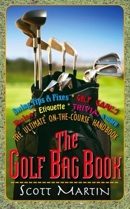The Golf Bag Book
During the late 1980s and early 1990s, the folks at Comedy Central ran a popular program called “Short Attention Span Theater.”
Hosted by comedians such as Jon Stewart, Patty Rosborough, and Brian Regan, the show featured movie clips from HBO and Cinemax, stand-up bits from comedians, and a mix of entertainment news and commentary by the host.
It was a great show for the easily distracted, because no one segment lasted more than a few minutes.
Scott Martin adopted that same approach in his newest offering, The Golf Bag Book, which should appear on the nation’s bookshelves in November (Burford Books, $14.95 SRP).
I think this attention deficit-oriented approach should work out well for him as well.
The book runs a slim 140 pages total, not counting the index. No segment runs longer than 10 pages, and most are a single page or two. Into this short space Martin manages to say something pithy, useful, and entertaining about thirty-seven different golf-related topics. As he says,
It’s not a rules book. It’s not a golf joke book. It’s not a book about Caddyshack. It’s not an etiquette book. It’s simply a companion on the golf course…when it comes to real-life issues, problems, and situations that routinely occur….
He’s got that right. If you’re wondering why your putts are pushing right or pulling left, instead of going in the hole, there are a couple quick hints about what to do about it.
If someone in your group is trying some gamesmanship during what turns out to be a less than friendly round, Martin has some good advice for you, and some needles for you to use in response.
For some of the more common rules situations that come up during a game, his solutions are far easier to comprehend than trying to flip through the USGA Rules of Golf on the fly.
At several points in this little gem, Martin reminds golfers of the need to manage their expectations to their actual playing level. The issue comes up in a piece about playing in the rain, a piece about club selection, and a short essay about playing hard holes, among other places.
It’s one thing to watch Phil Mickelson hit a wedge shot under one tree and over the next, onto the green for a classic escape from jail and a win in the Colonial. It’s a whole ‘nother thing to watch one of us regular types try the same thing, with predictably bad results.
In the segments about playing out of trouble, Martin stresses the advantages of accepting a bogey from a bad shot, instead of making double or triple bogey by following one bad shot with one or two more. Here’s what he says about expectations, in a passage most of us should commit to memory:
A good player (handicap plus to 5) should aim to birdie every hole. A decent player (handicap 5 to 12) should aim to par or birdie the easier holes but be happy with a bogey on a very hard hole. The average player (12 to 20) should be happy with the occasional par and a bogey on most holes. The ‘improving’ golfer (20 and above) should throw a party after a par and be delighted with bogey.
If more high-strung golfers would keep those ranges in mind, they might be far more pleasant playing companions.
Other portions of the book are just as enjoyable, although not perhaps as central to the playing experience.
Martin gives readers a short primer on some of the more influential golf course architects, enough to keep a conversation going about golf course design if it comes up during a round. He also discusses some of the better golf writers of yore, such as Bernard Darwin and Peter Dobereiner, while suggesting that the modern crop of golf writers includes too many Darwin or Dobereiner imitators (present company excluded, I hope).
This was a fun read. It should be on the early shopping lists for the upcoming holiday season for the golfers you know.
Review Date: October 9, 2009


